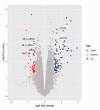Identification of key genes in allergic rhinitis by bioinformatics analysis
- PMID: 34334005
- PMCID: PMC8326637
- DOI: 10.1177/03000605211029521
Identification of key genes in allergic rhinitis by bioinformatics analysis
Abstract
Objective: This study aimed to explore the potential molecular mechanism of allergic rhinitis (AR) and identify gene signatures by analyzing microarray data using bioinformatics methods.
Methods: The dataset GSE19187 was used to screen differentially expressed genes (DEGs) between samples from patients with AR and healthy controls. Gene ontology (GO) and Kyoto Encyclopedia of Genes and Genomes (KEGG) pathway analyses were applied for the DEGs. Subsequently, a protein-protein interaction (PPI) network was constructed to identify hub genes. GSE44037 and GSE43523 datasets were screened to validate critical genes.
Results: A total of 156 DEGs were identified. GO analysis verified that the DEGs were enriched in antigen processing and presentation, the immune response, and antigen binding. KEGG analysis demonstrated that the DEGs were enriched in Staphylococcus aureus infection, rheumatoid arthritis, and allograft rejection. PPI network and module analysis predicted seven hub genes, of which six (CD44, HLA-DPA1, HLA-DRB1, HLA-DRB5, MUC5B, and CD274) were identified in the validation dataset.
Conclusions: Our findings suggest that hub genes play important roles in the development of AR.
Keywords: Allergic rhinitis; bioinformatics; differentially expressed genes; gene expression profile; gene ontology; hub gene.
Conflict of interest statement
Figures




Similar articles
-
[Progress of allergic rhinitis research based on transcriptome sequencing].Lin Chuang Er Bi Yan Hou Tou Jing Wai Ke Za Zhi. 2024 Jun;38(6):556-560. doi: 10.13201/j.issn.2096-7993.2024.06.019. Lin Chuang Er Bi Yan Hou Tou Jing Wai Ke Za Zhi. 2024. PMID: 38858125 Free PMC article. Review. Chinese.
-
Bioinformatics analyses of gene expression profile identify key genes and functional pathways involved in cutaneous lupus erythematosus.Clin Rheumatol. 2022 Feb;41(2):437-452. doi: 10.1007/s10067-021-05913-2. Epub 2021 Sep 23. Clin Rheumatol. 2022. PMID: 34553293
-
[Integrated bioinformatics analysis of key genes in allergic rhinitis].Zhonghua Er Bi Yan Hou Tou Jing Wai Ke Za Zhi. 2020 May 7;55(5):458-464. doi: 10.3760/cma.j.cn115330-20200123-00049. Zhonghua Er Bi Yan Hou Tou Jing Wai Ke Za Zhi. 2020. PMID: 32842359 Chinese.
-
Identification of key genes and the pathophysiology associated with allergen-specific immunotherapy for allergic rhinitis.BMC Immunol. 2023 Jul 10;24(1):19. doi: 10.1186/s12865-023-00556-1. BMC Immunol. 2023. PMID: 37430199 Free PMC article.
-
Identification of common core ion channel genes in epilepsy and Alzheimer's disease.Ir J Med Sci. 2024 Feb;193(1):417-424. doi: 10.1007/s11845-023-03447-x. Epub 2023 Jul 21. Ir J Med Sci. 2024. PMID: 37477849 Review.
Cited by
-
Allergic Diseases: A Comprehensive Review on Risk Factors, Immunological Mechanisms, Link with COVID-19, Potential Treatments, and Role of Allergen Bioinformatics.Int J Environ Res Public Health. 2021 Nov 18;18(22):12105. doi: 10.3390/ijerph182212105. Int J Environ Res Public Health. 2021. PMID: 34831860 Free PMC article. Review.
-
[Progress of allergic rhinitis research based on transcriptome sequencing].Lin Chuang Er Bi Yan Hou Tou Jing Wai Ke Za Zhi. 2024 Jun;38(6):556-560. doi: 10.13201/j.issn.2096-7993.2024.06.019. Lin Chuang Er Bi Yan Hou Tou Jing Wai Ke Za Zhi. 2024. PMID: 38858125 Free PMC article. Review. Chinese.
-
Analysis of urine differential proteins in patients with allergic rhinitis.Heliyon. 2023 Jun 17;9(6):e17323. doi: 10.1016/j.heliyon.2023.e17323. eCollection 2023 Jun. Heliyon. 2023. PMID: 37426793 Free PMC article.
-
Genes related to allergen exposure in allergic rhinitis: a gene-chip-based study in a mouse model.BMC Med Genomics. 2022 Nov 25;15(1):243. doi: 10.1186/s12920-022-01389-4. BMC Med Genomics. 2022. PMID: 36434595 Free PMC article.
-
Gene-Smoking Interaction Analysis for the Identification of Novel Asthma-Associated Genetic Factors.Int J Mol Sci. 2023 Jul 31;24(15):12266. doi: 10.3390/ijms241512266. Int J Mol Sci. 2023. PMID: 37569643 Free PMC article.
References
-
- Rotiroti G, Scadding GK. Allergic rhinitis-an overview of a common disease. Paediatrics and Child Health 2016; 26: 298–303.
-
- Kemp AS. Allergic rhinitis. Paediatr Respir Rev 2009; 10: 63–68. - PubMed
-
- Zou QY, Shen Y, Ke X, et al.. Exposure to air pollution and risk of prevalence of childhood allergic rhinitis - A meta-analysis. Int J Pediatr Otorhinolaryngol 2018; 112: 82–90. - PubMed
MeSH terms
LinkOut - more resources
Full Text Sources
Research Materials
Miscellaneous

